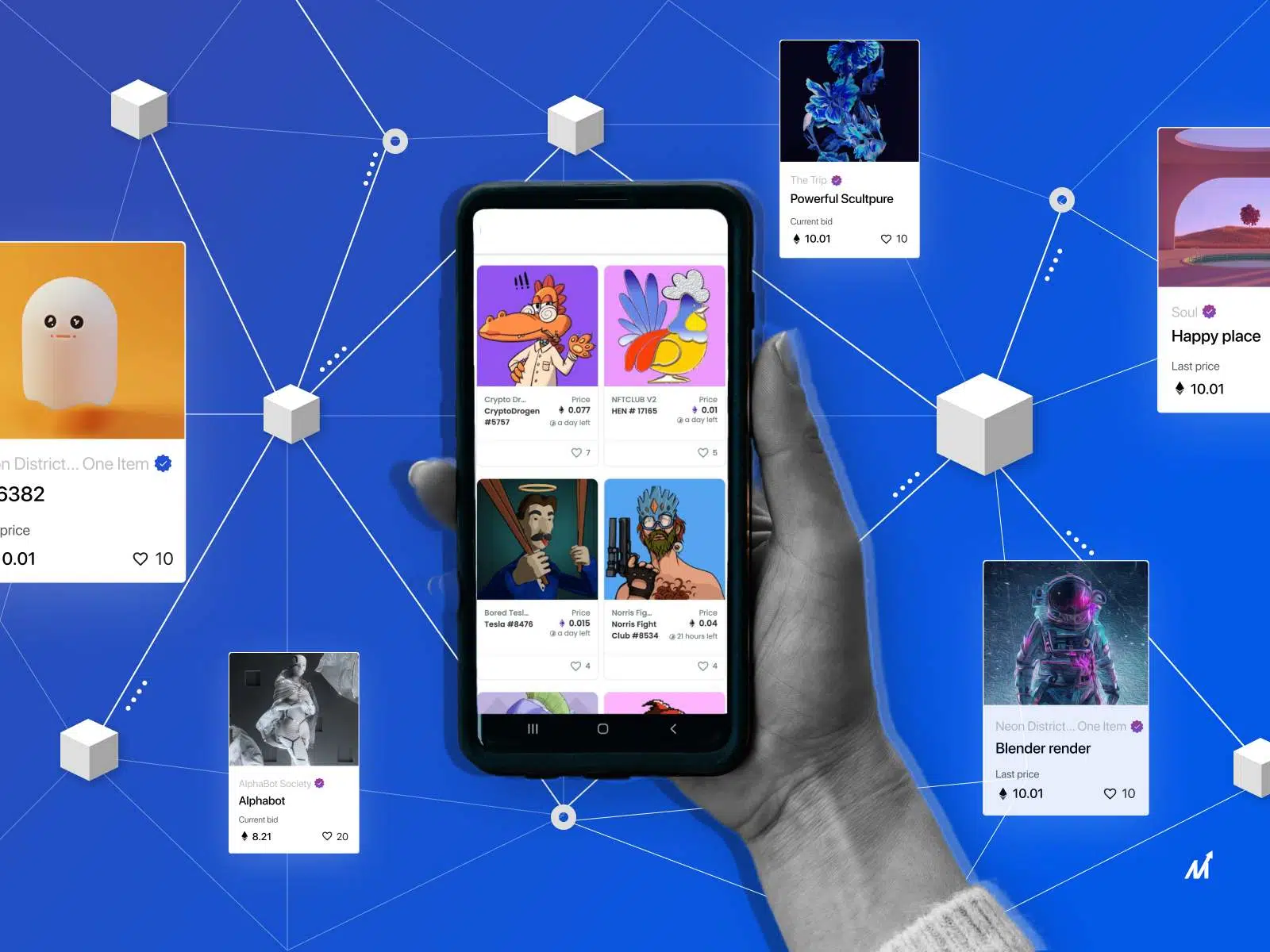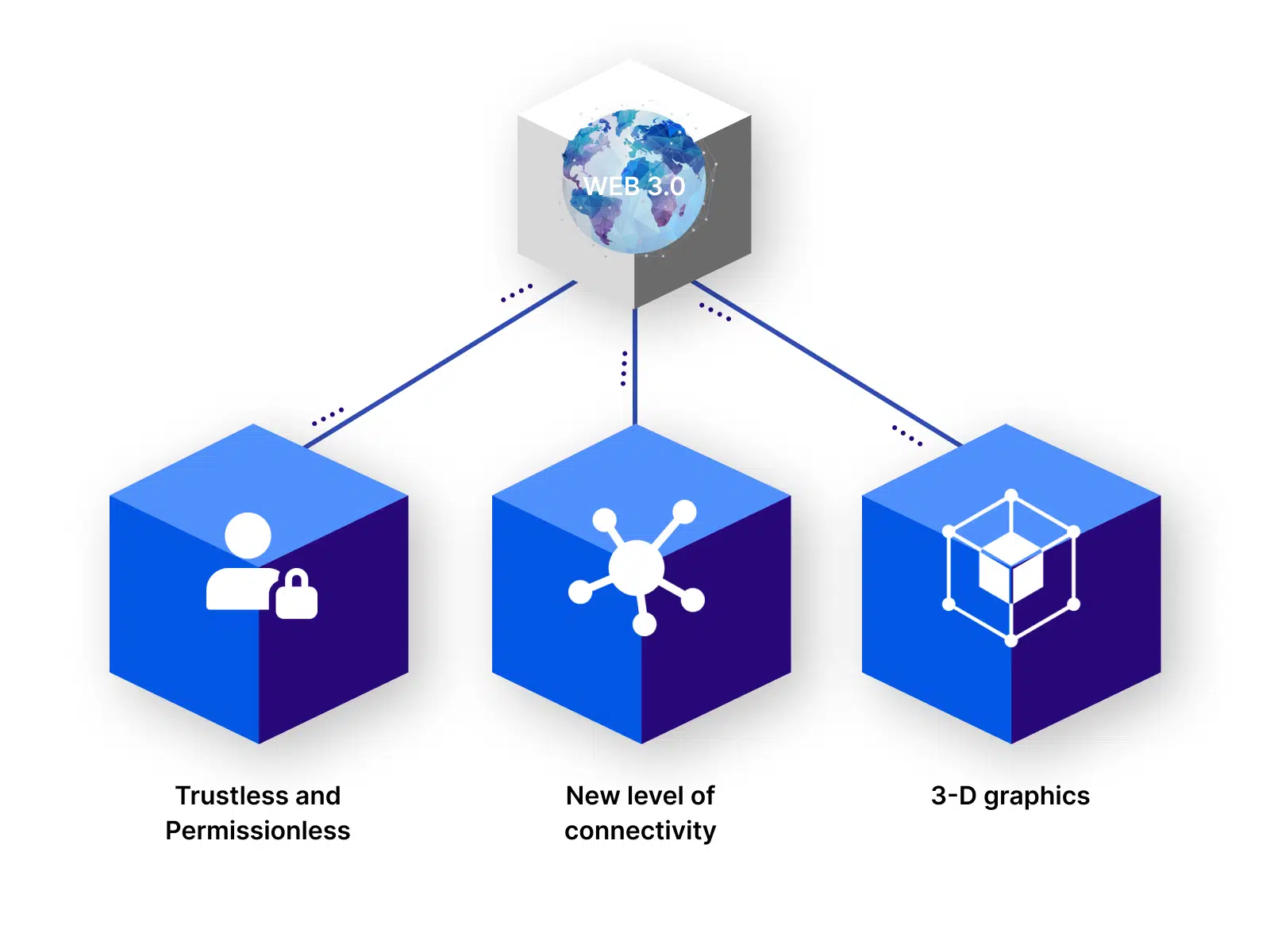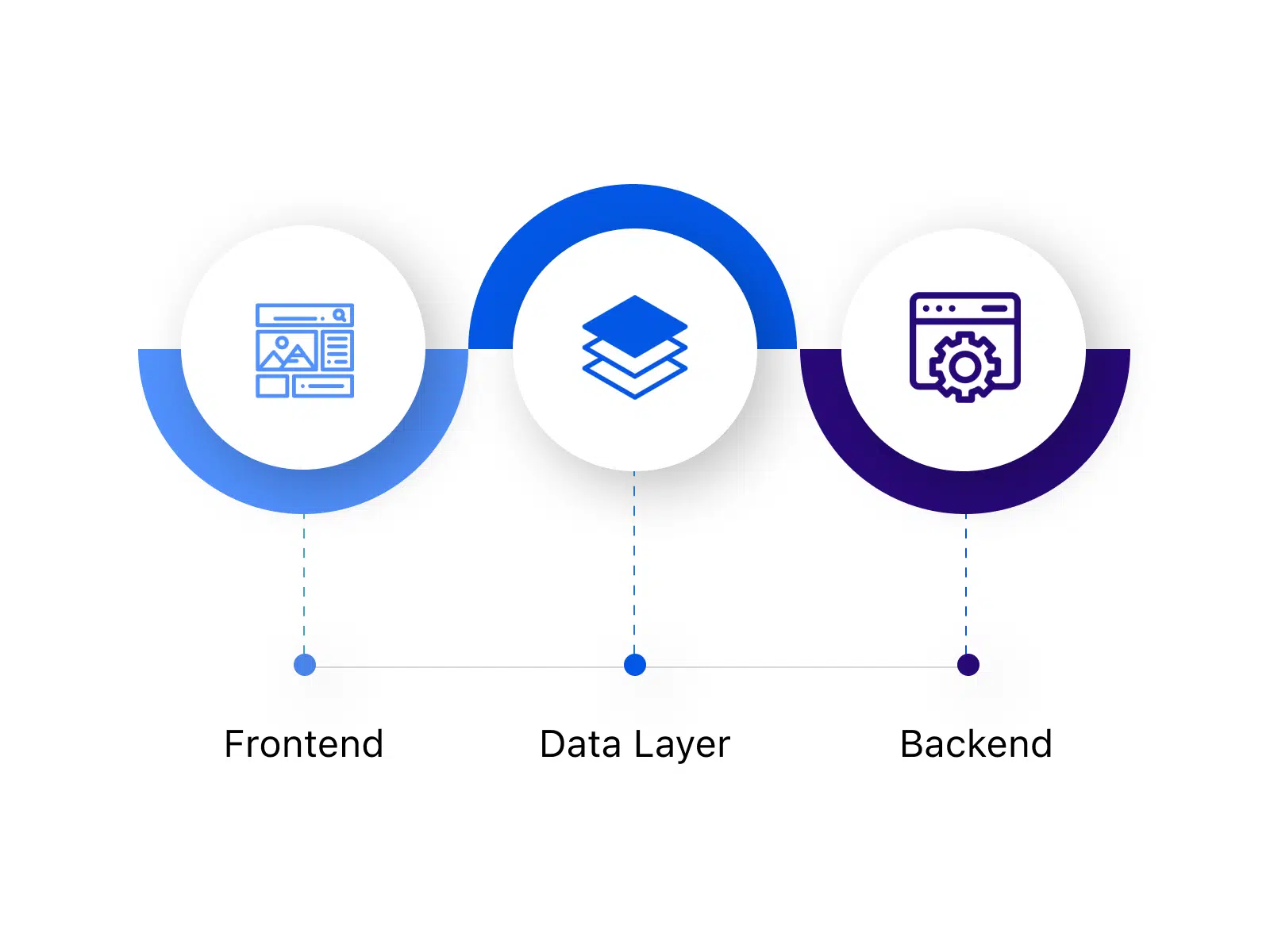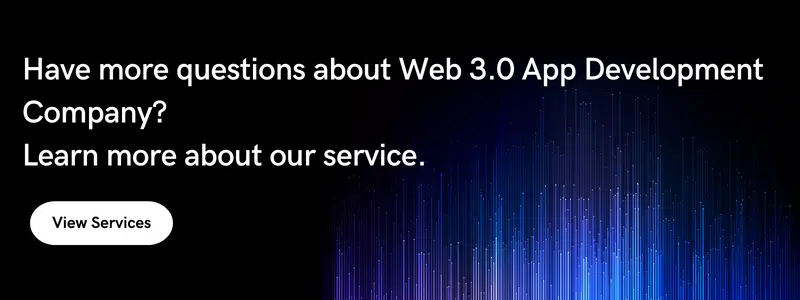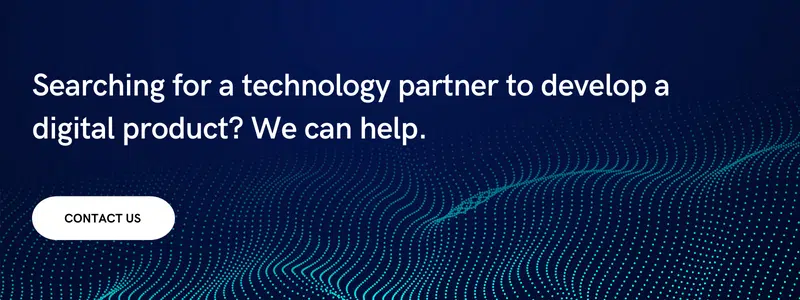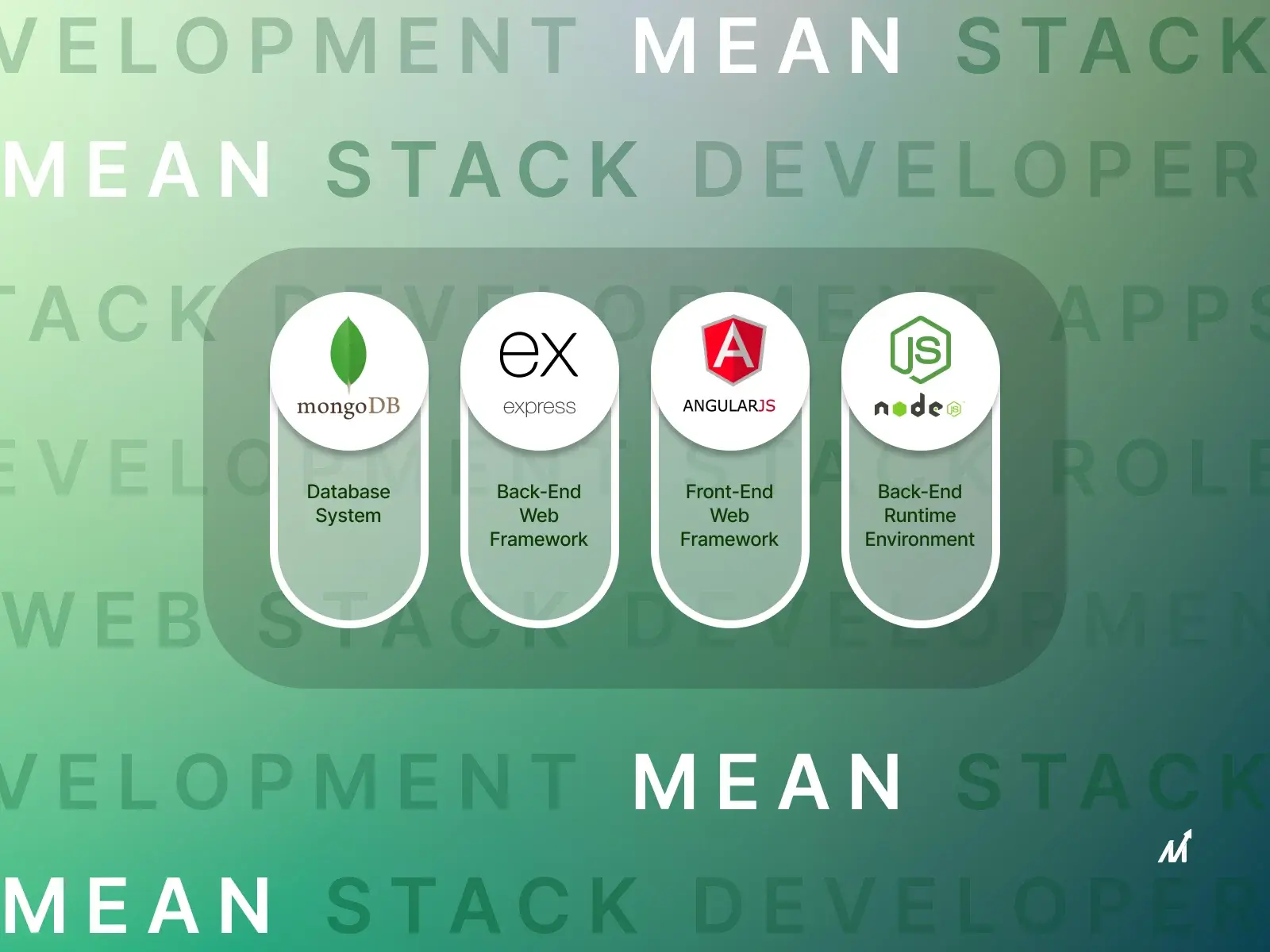Web3 Mobile Apps: Market Trend
The Web3 mobile apps are built on decentralization, openness, and enhanced user utility. The first web, Web 1.0, came into existence and used static web pages. This meant that the scope of user interaction was limited, and no advanced algorithms were used to improve the user experience.
The use of three fundamental technologies, HTTP, HTML, and URL, was implemented to develop this consumer-driven, ”read-only web,” and this started the WWW revolution. By utilizing technologies such as HTML, CSS, and Javascript, Web 2.0 created a more dynamic form. It was more advanced than Web 1.0, encouraged users to create content, made the Internet accessible to everyone, and used APIs to increase website functionality.
Web 3.0 has now brought a revolution in the tech industry, which was unthought of a few years ago. Evolving from the earlier forms, Web 3.0 believes in creating a decentralized and dynamic network powered by AI, Machine Learning, and Blockchain to allow intelligence to deliver content to Internet users.
The Web 3.0 revenue is expected to grow 35.4% from 2022 to 2029, reaching nearly US$ 64.38 Bn. The demand for a self-sufficient and open Internet is, thus, very evidently high. Therefore, understanding Web3 mobile apps and their work are essential for expanding the business and staying up-to-date.
Overview Of Web3 Mobile Apps Architecture
When creating a Web3 app, the frontend element can be the same as the Web2 mobile app. However, things are considerably different when we look at the application’s backend.
The Blockchain Node is the primary element in a Web3 app if we compare the backend portions of Web2 and Web3 apps. It manages the data dispersed across a decentralized network of Blockchain nodes. We rely on off-chain file storage and P2P networks to keep the data on the chain. For the highest level of security, it has incorporated private key-based authentication to confirm users’ identities.
It is crucial to remember that this is only a rudimentary illustration of Web3 architecture. There may be numerous versions and highly complex applications in use.
What Makes Web3 Different?
Web 3.0 is used to develop Web3 mobile apps to optimize their potential. These apps are used in various industries, from social media to gaming. They combine the best of technology to achieve previously impossible goals.
There are various factors due to which Web 3.0 stands out:
1. Trustless & Permissionless
Also referred to as the ”read, write and own web,” Web 3.0 believes in giving complete ownership of the Internet to its users and does not support third-party interference of any kind. Trustless and permissionless means anyone can join the network and interact, publicly or privately, without any authorization from anybody.
2. A New Level Of Connectivity
Web3 mobile apps integrate the use of IoT sensors and semantic metadata vastly. As a result, users can access all the information available without restriction, which increases their experience. The user gets the best experience possible, and the network formed by all the devices, not just smartphones and laptops, can interact better amongst themselves too.
3. 3-D Graphics
Till now, we have only seen dynamism in websites in the form of animations, 2-D graphics, GIFs, etc. Web 3.0 would employ three-dimensional design in websites and applications to give the users a real-life feel and make the network more interactive. Using 3-D graphics, e-commerce applications can create a shopping experience similar to a real store. The main aim is to minimize the gap between virtual and actual reality and completely change how users interact with applications.
Features of Web3 App
- Decentralized Architecture: Web3 applications shun central authority, operating instead on a heterogeneously dispersed node network. This architecture amplifies resilience against both network failures and malevolent attacks, ensuring robust fault tolerance.
- Data Transparency: Storing transactional information on a public blockchain ensures a layer of transparency that can be audited, thereby fortifying data integrity and facilitating external verification processes.
- Trust Minimization: Traditional trust dependencies are obviated through the utilization of smart contracts. These autonomous, blockchain-based algorithms enable verifiable, self-enforcing protocols, nullifying the need for third-party verification.
- Data Permanence: Once a transaction is cryptographically hashed and appended to the blockchain, its immutability is ascertained. Retroactive alterations or deletions are computationally implausible, thereby sustaining data fidelity.
- Asset Digitization: Frequently, Web3 applications leverage tokenized assets that might symbolize a multitude of values, ranging from financial instruments to user-rewards, codifying them into transferable, digital formats.
- Open-Source Foundation: The open-source nature of many Web3 applications fosters collaborative, community-driven development, enhancing the codebase through decentralized contributions.
- User Sovereignty: The control vectors of digital identities, access permissions, and data are frequently realigned to be user-centric, in stark contrast to centralized models, thus empowering users to exert superior control over their digital footprints.
Each of these components, from decentralized frameworks to user-centric control mechanisms, coalesces to construct a Web3 application that is simultaneously robust, transparent, and radically divergent from legacy internet architectures.
Web3 Use Cases
There aren’t many Web3 applications in businesses yet, but the public app market is booming. To name a few, there are NFTs, play-to-earn games, decentralized autonomous community organizations, and decentralized finance (DeFi). For example:
-
DeFi protocols like Aave and MakerDAO offer users to loan and borrowing services controlled by smart contracts, which do away with middlemen to enable larger yields and profits, albeit at a higher risk.
-
To sell their work, content creators like artists are employing NFT smart contracts. These contracts ensure that they, not middlemen, are paid according to the conditions of the contract that they specify whenever, for example, they sell a work of art.
-
NFT-based play-to-earn games give players a way to generate revenue. These games have also given rise to nonprofit groups that use gaming revenue to support scholarships for users from poor backgrounds.
There are few successful Web3 implementations in well-established industries, and big businesses will likely be slow to relinquish governance, monitoring, and control of the applications they use in collaboration with other actors in the digital ecosystem. However, most businesses will eventually wish to embrace the new business models and prospects that Web3 alone promises to enable, as well as applications and procedures that profit from trust-minimized computing.
Web3 Mobile Apps: Architecture Explored
Web3 mobile apps, also known as dApps ( decentralized applications), differ from Web 2.0 because it eliminates the need for centralized databases and servers to facilitate interaction with the user. In Web 3.0, everyone participating in the network maintains the decentralized state machine collectively and with full ownership.
Frontend
The Frontend layer interacts mainly with the smart contracts to connect to the nodes. This is not a typical backend-frontend interaction. Each node carries the machine’s state, and for interaction, the user must set up their node or use third-party providers such as Alchemy. These providers communicate with the Blockchain network using JSON-RPC ( Remote Procedure Calls) and allow the client to retrieve the response from the state machine.
As soon as the user node is connected, they become part of the Blockchain network, where it can read/write. This is done with the help of encryption, using the client’s private key when any transaction is requested. Metamask, a third-party provider, is used for this purpose, i.e., to store the clients’ private keys and sign the transactions. The other nodes (or miners) verify it after reaching a mutual consensus, after which the transaction is executed. A gas fee might also be charged to distribute amongst the other miners and keep the self-sufficient network going.
Data Layer
As blockchain networks require gas fees to store data, P2P solutions are preferable. For example, IPFS ( Inter Planetary File System) is a peer-to-peer file system protocol that allows public/private gateways to connect to the network. All the data is accessible via decentralized protocols like IPFS, Filecoin, and UCAN, which enables a trustworthy and reliable data layer. When querying the blockchain or P2P network, The Graph can convert GraphQL queries into smart contracts and peer-to-peer getaways.
Backend
The backend works based on smart contracts, which keep the blockchain network going. A decentralized network is necessary for dApps to function. Thus, all the nodes in the network maintain the state machine with the help of mutual consensus, which validates the program’s stability throughout. Each node in the network can contribute and participate, making it restriction-free and open to everyone.
All the blockchain P2P network nodes conclude pre-defined rules. Thus, no centralized authority has overall control, and everyone gets to participate equally. The most used Blockchain platform is Ethereum. These contain Smart Contracts, which can connect to any API and attain external data.
Tech Stack Needed to Build Web3 Apps
To engineer a decentralized application in the Web3 ecosystem, a meticulous selection of tech stack is indispensable. Here is what you need:
- Distributed Ledger Infrastructure: Ethereum remains the de facto substrate for this new class of applications, facilitating decentralized consensus and transactional logic.
- Contract-Oriented Languages: For smart contracts, which are auto-executable protocols governing transaction rules, Solidity serves as the prevailing coding vernacular.
- Ethereum-compatible JavaScript API: Web3.js functions as the essential bridge for client-side interactions with Ethereum’s blockchain, enabling tasks like transaction initiation and data retrieval.
- Decentralized Hypermedia Protocol: IPFS (InterPlanetary File System) ushers in a novel, peer-to-peer storage and file sharing mechanism, eliminating single points of failure and enhancing data integrity.
- Digital Asset Custodians: Wallets like MetaMask are integral to user interactions with Web3, serving as the gateway for transaction signing and asset management within Ethereum’s ecosystem.
- Verifiability Solutions: In an environment where immutability and security are paramount, tools like Truffle and Ganache offer a sandbox for rigorous smart contract validation.
- Rapid Development Toolchains: Frameworks such as Embark and DappHub expedite the development lifecycle by offering pre-configured environments and deployment pipelines.
Overall, to architect a robust Web3 application, a composite toolkit encompassing distributed ledger technology, contract-oriented languages, client-side APIs, P2P file systems, digital asset management solutions, contract testing utilities, and rapid development frameworks is not just preferable but essential.
Web2 Frontend vs Web3 Frontend
An application’s frontend allows a user to query and post to a database in Web2; this remains the case in Web3. A Web3 frontend developer’s primary responsibilities are similar to those of a Web2 frontend developer in that they implement everything consumers view. Web3 frontend developers often need the same skills, including knowledge of HTML, CSS, JavaScript, React.js, etc.
The primary distinction is Web3.js, a set of JavaScript modules that enables communication with an Ethereum node. In summary, Web3.js offers an API that allows us to connect to the blockchain node and interact using an HTTP or IPC connection.
Markovate & Web 3.0: Our Experience
Markovate, as a Web 3.0 App Development Company, aims to provide enterprises with the best developers. We have extensive knowledge of the technologies used to implement applications.
Web3 mobile app architecture can be pretty complex, and its development process is quite tedious. Our services and experience in developing Web3 solutions using technologies like AI, Blockchain, cryptography, and programming languages like Rust and Solidity, can create dApps that are secure, reliable, smooth, and updated with the latest technology in the market.
Our team of experienced Web3 developers supports businesses throughout the process. It helps to create scalable products that provide users with a unique digital experience and incorporate all the elements per business needs.
Further Read: Web3 vs Metaverse: Everything You Need To Know
Web3 Mobile Apps: Commonly Asked Questions
1. Is Web3 a metaverse?
It is important to note that Web3 mobile apps and Metaverse are not synonymous, even though they use similar technologies. Web 3.0 is a decentralized model for the Internet, whereas Metaverse is an experience created using a network of virtual worlds.
2. What are some benefits of Web3 Mobile Apps?
Web3 mobile apps encourage ownership, increased security of the user’s data, faster transactions, and encrypted storage, along with incorporating remarkable technologies such as 3-D Graphics and Blockchain, which result in an enhanced and secure user experience.
3. What are some industries where Web 3.0 Mobile Apps are used?
Numerous industries are adopting Web3 mobile apps, including banking, gaming, networking, e-commerce, and healthcare.

